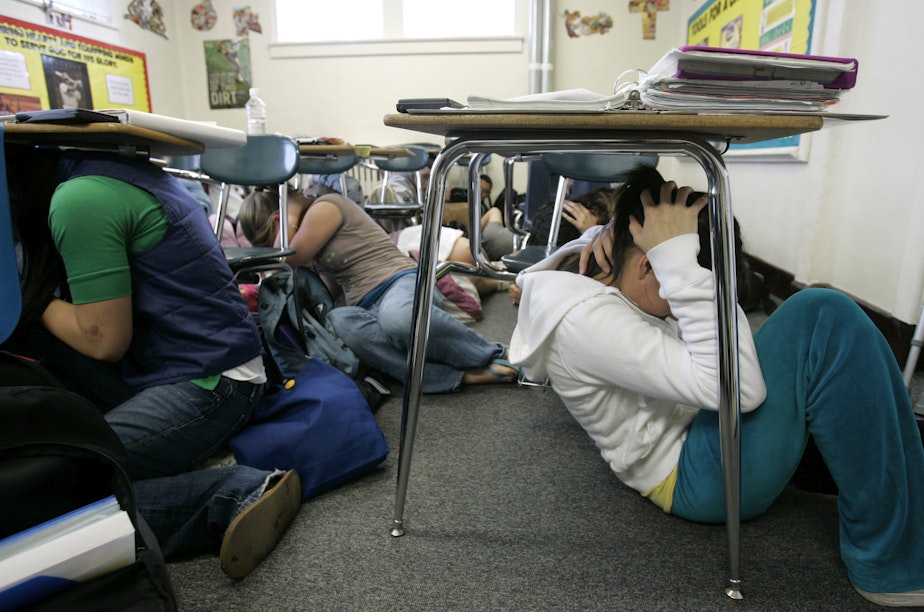All shook up: Remembering the Nisqually Earthquake 20 years later

Western Washington was shaken at 10:54 a.m. Wednesday, February 28, 2001.
KUOW's Robert Smith was at the Westin Hotel where Bill Gates was introducing a new version of Windows. A Microsoft leader was speaking when the chairs and tables began to shake.
"Then the the sound system cut off, the backdrop behind Bill Gates start to sway, and the giant chandeliers in the ballroom began to sway"
In the KUOW newsroom, everyone froze. News Director Terry Fitzpatrick screamed, "Get under your desk."
The quake had a magnitude of 6.8. Fortunately for the region, this was a deep earthquake, which caused less surface shaking. Officials called it the Nisqually quake after the delta where the quake was centered northeast of Olympia. After the shaking subsided, we spent the afternoon at KUOW taking calls from listeners.
"The ground started to shake, and then I'm like, 'Guys stop shaking the table,'" said 11-year-old Deseret, who was at school when the quake struck. "We went under the table for a few like minutes. And then our principal came on the intercom and said, 'Evacuate the building.' I'm like, OK, say no more. I'm outta here!"
Sponsored
Maddie was also at school: "First, I thought it was a crow dragging a piece of meat across the roof. I thought it was a jackhammer working outside."
Molly was driving over Lake Union on the I-5 bridge: "It it felt as though I were in a speedboat, driving over diagonally approaching ways."
Lisa worked at a laboratory. She was stepping onto an elevator, carefully carrying a liter-sized bottle of a highly toxic chemical.
"Then the elevator started shaking and I was shaking and my hands were starting to sweat I had hand lotion on — anyways I'm kind of clutching the bottle there in the elevator for what seemed like a really long time. And then my elevator was stuck, so then I sat in there for half an hour with toxic chemicals."
It wasn’t just humans that were affected. We heard many stories about animals’ reaction, including from Woodland Park Zoo spokesperson Gigi Allianic.
Sponsored
"Just before it hit, the mother of our elephant calf Chai was just about to have a blood sample drawn from her," Allianic said.
"She immediately bolted up just a second before the earthquake hit. And once she jumped up, and the earthquake hit, the entire herd just started trumpeting loudly, vocalizing. The glass in the barn was rattling, and her calf was pretty frightened. In fact, she roared and as elephant calf do; she sought protection under her mother's belly."
Airports were closed, schools and buildings evacuated. One person died of a heart attack, and several hundred were injured in the Nisqually earthquake. Property damage was in the billions. Bricks fell from older buildings all over the region. The control tower at SeaTac Airport was severely damaged. But all in all, we got off pretty light, Seattle Mayor Paul Schell.
"Being prepared is one of the lessons from this that we can minimize damage. We need to continue to be repaired and take this as a reality check that this is an event that can and will happen in our community. And that will weather the next one, should it occur — I hope not while I'm mayor — in the future."
Following the Nisqually quake, officials decided to take down the Alaskan Way Viaduct along Seattle's waterfront because of fears it would collapse in another quake. And today you can see the legacy of the Nisqually earthquake under some Seattle bridges. Look up, and you'll see huge square plates affixed to the underside to strengthen them just in case there's a next time.




